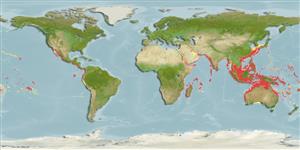>
Carangiformes (Jacks) >
Carangidae (Jacks and pompanos) > Caranginae
Etymology: Decapterus: Greek, deka = ten + Greek, pteron = wing, fin (Ref. 45335).
More on author: Bleeker.
Environment: milieu / climate zone / Tiefenbereich / distribution range
Ökologie
seewasser riff-verbunden; tiefenbereich 20 - 214 m (Ref. 58302), usually 30 - 70 m (Ref. 37816). Tropical; 39°N - 34°S, 180°W - 180°E
Southeast Atlantic: from Knysna to Natal, South Africa. Indian Ocean: along East Africa, Red Sea and Persian Gulf to Northwest Australia. Pacific: from South Korea, Australia and Central Pacific Islands, to Gulf of California to Peru, including Galapagos Islands (Ref. 9283). Recors in southwestern and South Australia are incorrect.
Length at first maturity / Size / Gewicht / Alter
Geschlechtsreife: Lm 16.8 range ? - ? cm
Max length : 35.0 cm TL Männchen/unbestimmt; (Ref. 3197); common length : 25.0 cm TL Männchen/unbestimmt; (Ref. 9137)
Rückenflossenstacheln (insgesamt) : 9; Rückenflossenweichstrahlen (insgesamt) : 33 - 38; Afterflossenstacheln: 3; Afterflossenweichstrahlen: 27 - 30. Body slender, elongate, and somewhat circular in cross section; posterior end of upper jaw concave dorsally and with a rounded protrusion ventrally; edge of shoulder girdle (cleithrum) with two small papillae, the lower one larger; dorsal and anal fin each followed by a separate finlet (Ref. 55763). Color metallic blue dorsally, silvery ventrally; fins hyaline; opercle with a small black spot (Ref. 2334). 24-40 scutes. Very slender compared to similar species (Ref. 48635).
Body shape (shape guide): fusiform / normal; Cross section: compressed.
A predominately pelagic schooling species (Ref. 9283, 48635, 58302). Occasionally seen in small groups along reef slopes adjacent to deep water in pursuit of zooplankton (Ref. 48635). Adults feed mainly on small invertebrates (Ref. 5213). Marketed fresh and salted or dried (Ref. 9283).
Paxton, J.R., D.F. Hoese, G.R. Allen and J.E. Hanley, 1989. Pisces. Petromyzontidae to Carangidae. Zoological Catalogue of Australia, Vol. 7. Australian Government Publishing Service, Canberra, 665 p. (Ref. 7300)
IUCN Rote Liste Status (Ref. 130435: Version 2025-1)
Bedrohung für Menschen
Harmless
Nutzung durch Menschen
Fischereien: kommerziell; Köder: usually
Tools
Zusatzinformationen
Download XML
Internet Quellen
Estimates based on models
Preferred temperature (Ref.
123201): 22.1 - 28.6, mean 27.3 °C (based on 829 cells).
Phylogenetic diversity index (Ref.
82804): PD
50 = 0.5005 [Uniqueness, from 0.5 = low to 2.0 = high].
Bayesian length-weight: a=0.01000 (0.00852 - 0.01174), b=2.97 (2.94 - 3.00), in cm total length, based on LWR estimates for this species (Ref.
93245).
Trophic level (Ref.
69278): 3.4 ±0.45 se; based on food items.
Generation time: 1.2 (1.1 - 1.3) years. Estimated as median ln(3)/K based on 47
growth studies.
Widerstandsfähigkeit (Ref.
120179): hoch, Verdopplung der Population dauert weniger als 15 Monate. (K=0.50-1.60; Fec = 43,000).
Prior r = 1.11, 95% CL = 0.73 - 1.67, Based on 3 data-limited stock assessments.
Fishing Vulnerability (Ref.
59153): Low vulnerability (16 of 100).
🛈
Nutrients (Ref.
124155): Calcium = 252 [86, 571] mg/100g; Iron = 2.71 [1.03, 5.61] mg/100g; Protein = 20.4 [19.1, 21.6] %; Omega3 = 0.221 [0.118, 0.405] g/100g; Selenium = 73.4 [27.8, 171.8] μg/100g; VitaminA = 48.8 [16.3, 163.0] μg/100g; Zinc = 1.31 [0.80, 2.07] mg/100g (wet weight); based on
nutrient studies.
